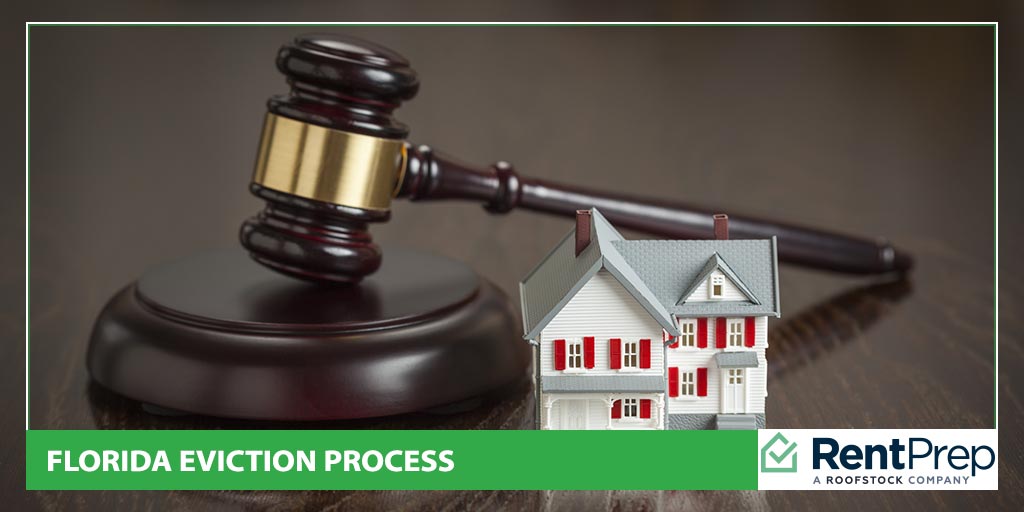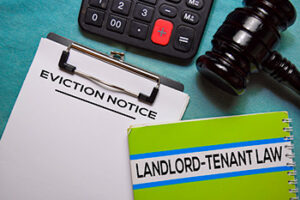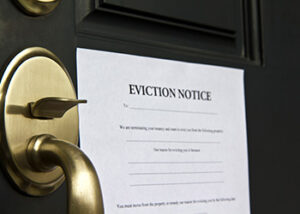
We know first-hand why so many landlords face fear and intimidation whenever they have to start the eviction process. Even when you aren’t making money on your properties because a tenant isn’t paying rent or they aren’t following the rules in your lease, eviction is often an unwanted solution because of the complicated rules.
As a landlord, however, it’s up to you to use the law on evictions to your advantage to ensure that you can keep control of your properties while also keeping them profitable and well-kept for the future of your business.
When working in Florida, you’ll need to become familiar with the Florida eviction process. Every state has its own rules, and the Florida law on evictions may be different than what you expect when it comes to notice periods and filing rules. If you mess up while filing, you might even have to waste your time starting from the beginning!
That is why we have put together this guide for landlords on the eviction process in Florida. By following through the steps outlined here, you won’t be caught off guard while evicting a tenant in Florida.
A Table Of Contents For Florida Eviction Statutes
- What Is Eviction?
- What You Can’t Do As A Landlord
- Eviction Timeline In Florida
- Overall Eviction Process: Step-By-Step
- Notices For Evictions With A Cause
- Notices For Other Types Of Eviction
What Is Eviction?
Before we get into the specifics of what the eviction process in Florida looks like, let’s talk more generally about eviction, what it is, and when you might find the eviction process useful.
Simply defined, an eviction is when the tenant must leave the property for some reason that has been outlined by the landlord or property manager. There are many different reasons for eviction. The bottom line of all of the reasons, however, is that you, as a landlord, have the legal right to control how your property is used and can evict a tenant if rules aren’t followed.
Common Eviction Reasons

As mentioned, there are many different reasons you might decide to evict a tenant. Most landlords find the following problems are most likely to lead to eviction:
- Nonpayment of rent
- Illegal activity happening on the property
- Consistently paying rent late
- Property is being sold or will be otherwise uninhabitable
- Lease terms are not being followed
Of course, there are many other valid reasons for eviction!
Most reasons, however, tend to boil down into one of these categories when you examine them more closely. It is important that you carefully consider the reason you are considering eviction and decide what category it falls in. The category will decide how you should handle the exact eviction process, so knowing this can help you be more efficient.
What You Can’t Do As A Landlord
A lot of parents tell their kids, “my house, my rules” when they want to enforce their rules around the house. Can landlords say the same thing to tenants who have signed a lease to live in their property?
The answer is yes, but no. While you as the landlord are allowed to dictate the terms of the lease that is signed within reason, there are, of course, limitations to what areas you are allowed to control.
Even if it is your property, you cannot evict someone because of their religion, race, sexuality, or other protected class status. Additionally, you cannot tell them to leave simply because you don’t like them! Once you’ve signed a lease, they gain a legal right to live there.
That means that until you have a valid case for eviction and the proper documents, you cannot try to force them to leave. There have been landlords in the past that have stooped to do one or more of the following things trying to get a tenant to leave:
- Turn off utilities
- Block their parking spot
- Forcibly remove the tenant or their belongings
- Change the locks
- Blackmail them
- Threaten them
- Take doors off the house
You can absolutely never do any of those things under the Florida eviction statutes.
Until you have officially filed for eviction and had that eviction approved, you cannot force the tenant to do anything.
Eviction Timeline In Florida
Before we get into the nitty-gritty details of how to evict someone in Florida, let’s talk about the eviction timeline in Florida.
If the eviction goes as smoothly as possible, the tenant would leave immediately once they receive notice. This means that they could be out in as little as three days. Realistically, however, most standard evictions in Florida take between three and four weeks to be completed.
In more complicated cases, however, evictions can stretch out for two or more months before anything is resolved, and it might take even more time than that to receive any back payment of rent that you are owed depending on the specific situation.
The key to eviction is that no matter how long it takes, you stay patient and continue to follow the rules. If you skip ahead, you will find that you are likely to make a mistake and have to start at the beginning of the eviction process again! That will take even longer, so move at a steady and careful pace throughout the process.
Overall Eviction Process: Step-By-Step
Now, let’s get into the actual eviction process! This section of today’s landlord guide will walk you through what you need to do at every turn in order to complete a successful eviction in Florida.
Remember, however, that laws can change. Be sure that staying up-to-date with the local and state laws that might affect how you need to handle your rental business.
Step 1: Identify The Reason For Eviction
The first thing you need to do is decide why are you going to evict the tenant. Is their late rent? Are they parking illegally? Did they break the sink on purpose? No matter what the reason is, identify and collect evidence of it before you do anything else.
Step 2: Send Notice

Regardless of how serious the infraction is, you will need to give your tenant an eviction notice before you can proceed with any type of eviction hearing.
There are a number of different types of notices that can be used in the varying eviction situations you will come across while working as a landlord. The following two sections of today’s article will go into the notice types in more detail.
When you send a notice, be sure that you send it through certified mail so you have a copy of the receipt. Additionally, it is a good idea to hand deliver a copy of the notice as well, so you have no doubts about whether or not the tenant got the notice.
Step 3: The Waiting Period
Regardless of the type of notice you give, there will be a waiting period. In some cases, you’ll be waiting for the tenant to pay their rent or fix a problem. In other cases, you’ll be waiting to see if the tenant moves out or not.
Regardless, you must make it through the entire waiting period before you take any further action.
Use this time to gather additional proof and gather your documents for a potential eviction hearing. This is especially important to start early if you do not believe that the situation will be remedied without court involvement.
Step 4: Filing For Eviction
If the tenant does not take any action, you will need to go to your local courthouse and file the appropriate papers for eviction.
Once you file the complaint, the lawsuit will start. From here, the court will send out the eviction complaint and summons to both you and the tenant. These documents are legally binding for both parties, so you will be expected to present your case in court as well if it makes it to a judge.
The tenant will have a short amount of time to respond to the complaint. There are a few different ways that tenants may respond:
- The tenant may file their own complaint with the court if they disagree with your reason for evicting them. This report will also be sent to you.
- The tenant may not respond. If they do not respond, the court will likely rule against them and then send the tenant a bill for rent owed.
- The tenant may agree to pay rent but disagree about the amount. This disagreement would also need to be filed through the court.
Depending on how the tenant responds to their court summons, you may need to go to court to defend your reasons for eviction. Before you get to the court, however, there is likely to be a week or two of back-and-forth between you, the tenant, and the court to decide whether or not the case can be resolved without a hearing.
Step 5: The Hearing
If the court needs to see more information to make a judgment, both you and the tenant will be given a court date.
Before going to court, prepare any receipts, photos, documents, notices, and other proof that you have of your reasons for evicting the tenant. These will be of the utmost importance when presenting your case to the judge.
If the tenant does not show up, you will win by default.
If the tenant does show up, the judge will make a decision during the hearing.
If you win the hearing, you will be granted a Judgment for Possession, which allows you to help get your property back under your control.
Step 6: The Eviction
When the court hearing ends, your Judgment for Possession will be passed to the local Sheriff as a writ of possession. This document allows the Sheriff to post a 24-hour move out notice to the tenant on your behalf.
If the tenant does not leave within those 24 hours, the Sheriff can then have the tenant forcibly removed and the locks can be changed. Finally, the property will be yours again!
Notices For Evictions With A Cause
The first Florida eviction statutes we will talk about are the cases where you are evicting someone for a specific reason, such as a broken lease. In these cases, there are detailed rules about how much notice you must give and what other things you must do during the eviction.
We’ll discuss each type of case depending on which notice you would need to send out for that eviction reason. There are three main notice types used when doing an eviction for a specific reason in Florida.
3-Day Notice Florida: Pay Rent or Quit
 The first and most commonly used type of notice in Florida is the 3-day notice to pay rent or quit.
The first and most commonly used type of notice in Florida is the 3-day notice to pay rent or quit.
This notice is used whenever a tenant has not paid rent on time. The notice can be given as soon as the rent is late and any grace period outlined in the lease has passed.
Here’s how this notice works:
- The notice is delivered.
- The tenant has three days to pay rent or leave the property.
- If they do not do anything, the tenant can file for eviction after the three day period is over.
When calculating the three day period, be sure that you do not include any weekends or holidays. Also, it’s best to send a copy of the notice in the mail as well as giving it to the tenant directly. This ensures that you have proof of when the notice was received.
7-Day Notice To Fix
Sometimes, a tenant will break the terms of your lease agreement. Often, these violations are things that the tenant can remedy if they choose to. If your tenant has committed a violation that can be corrected, you will want to use the 7-day notice to fix.
Here’s how this notice works:
- Send the notice as soon as you discover the violation.
- The tenant will have seven days to fix the problem as outlined in the notice so that they are no longer in violation of the lease.
- If the tenant does not fix the problem or come to another arrangement with you in seven days, you can file an eviction lawsuit.
7-Day Quit Notice
There are going to be times when a tenant does something that cannot be remedied or is more serious than a simple lease violation. In Florida, the eviction law states that a 7-day notice to quit can be used in the following scenarios:
- Tenant destroys the property on purpose
- Tenant destroys other tenants’ property on purpose
- Tenant repeats the same lease violation within a one-year period
- Tenant creates illegal or otherwise unreasonable disturbances
When you send this notice, the tenant does not have a chance to fix anything. They simply must move out of the property within seven days. If they do not, you are legally permitted to file for an eviction.
Other Types Of Eviction
Sometimes you will want to end the lease agreement you have with a tenant for other reasons that have nothing to do with rent payment or lease violations. For example, you might have tenants who are currently in a month-to-month contract with you, but you no longer want to rent the property out monthly.
There are two cases in Florida where you would handle the eviction process in another way because of this difference from the with-cause evictions listed above.
Fixed-Term Lease Evictions
To end a fixed-term lease without cause, you must wait until the end of the term to end the tenancy. You will not, however, need to give the tenant any particular notice unless the lease outlines an automatic renewal. In that case, you will need to give them the appropriate notice as outlined in the original lease. Typically, this is at least one month’s notice.
Month-To-Month Lease Evictions
Most month-to-month leases are written to automatically renew every month until the lease is terminated. If you want to end a monthly lease but do not have a specific cause, you will need to give the tenant at least 15 days’ written notice, which outlines exactly when the tenant needs to move out by.
Eviction: Complicated But Not Impossible
As you’ve probably noticed, the Florida eviction process can be quite overwhelming due to the number of steps that you’ll need to go through. But it’s certainly not impossible!
Many landlords are hesitant when it comes time to send out an eviction notice because they want to give their tenant the benefit of the doubt. Even good tenants sometimes need a reminder that they have rules to follow, so don’t be afraid to send out a notice.
Remember: You are a business, and your goal is to profit. If you don’t use eviction as the law permits, you will be stuck in tough situations where you’re losing money left and right. Don’t let that happen to you!

